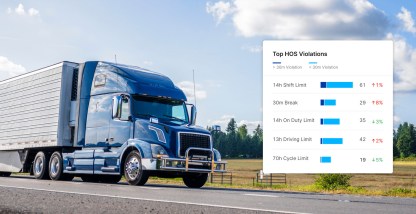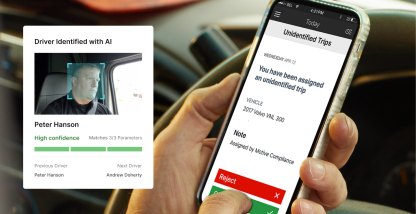Sometimes, commercial drivers are exempt from some hours of service rules. And those exemptions usually relate to the 30-minute rest break, 14-hour period, and 11-hour rule. Confused? Let’s break it down…
The Federal Motor Carrier Safety Administration (FMCSA) has developed several hours of service rules and regulations. The goal of these HOS rules? To reduce driver fatigue and improve safety for everyone on the road.
The rules are straightforward. But there are four exceptions that drivers and fleet managers need to know about.
Before we dive in, here’s a quick recap of the important hours of service rules.
1. What is the 14-hour rule?
According to the 14-hour rule, a property-carrying driver can’t drive beyond the 14th consecutive hour after coming on duty. The driver can’t resume driving unless they’ve taken 10 consecutive hours off-duty.
For passenger-carrying motor vehicles, the limit is 15 cumulative hours.
For both property-carrying and passenger-carrying vehicles, off-duty time does not extend the 14-hour period.
2. What is the 11-hour rule?
The 11-hour rule says that, within the 14-hour window, a property-carrying driver can drive a maximum of 11 hours after 10 consecutive hours off duty.
Passenger-carrying drivers can drive up to 10 hours after eight consecutive hours off duty.
3. What is the 30-minute break rule?
According to the 30-minute break rule, drivers can’t log driving time if eight hours have passed since the last off-duty period of 30 consecutive minutes. Drivers can perform non-driving tasks after eight hours without taking a break, but they can’t drive.
Now, it’s time to dive into the four hours of service exceptions we mentioned earlier.
Hours-of-service exemption #1: the 30-minute break exception
Two types of drivers are exempt from the 30-minute break rule:
- Short-haul drivers who qualify for the 100 air-mile radius provision.
- Short-haul drivers who qualify for the 150 air-mile radius provision and operate non-CDL vehicles.
Hours-of-service exemption #2: the 16-hour short-haul exception
Under the 16-hour short-haul exception, qualifying drivers can extend the 14-hour driving window to 16 hours once every seven consecutive days.
A property-carrying driver can use this exception if they:
- Have returned to the their normal work reporting location, and the carrier released the driver from duty at that location for the previous five duty tours the driver has worked
- Have returned to the normal work reporting location, and the carrier releases the driver from duty within 16 hours after coming on duty following 10 consecutive hours off duty
- Haven not taken this exemption within the previous six consecutive days, except when the driver has begun a new seven or eight-consecutive day period with the beginning of any off-duty period of 34 or more consecutive hours as allowed by §395.3(c).
Drivers who use the 16-hour short-haul exception can’t use the non-CDL 150 air-mile exemption.
Hours-of-service exemption #3: adverse driving conditions
Under the “adverse driving conditions” exemption, drivers can sometimes extend the maximum driving limit by two hours.
When is the adverse driving conditions exemption applicable?
This exemption only works when the adverse driving conditions could not have been known before the driver started driving.
Circumstances include weather changes, such as unexpected fog or snow or the closure of a road due to unforeseen events, such as an accident.
The exemption doesn’t apply if the driver had previous knowledge of the adverse driving conditions or could have known of the conditions through basic trip planning or common sense. A forecasted blizzard or typical rush hour traffic don’t count.
How does the adverse driving conditions exemption affect property-carrying drivers?
Property-carrying drivers can drive a maximum of 11 hours per shift. The adverse driving conditions exemption extends the 11-hour driving limit to 13 hours.
This exemption does not extend the 14-hour driving period. It means that all 13 hours of driving must still be completed within the 14-hour window.
How does the adverse driving conditions exemption affect passenger-carrying drivers?
Passenger-carrying drivers can drive a maximum of 10 hours per shift. The adverse driving conditions exemption extends the 10 hours of drive time to 12 hours.
Again, this exemption does not extend the 15-hour driving period for passenger-carrying drivers.
Hours-of-service exemption #4: direct emergency assistance
A CMV driver has to comply with all hours of service regulations. But in emergencies, some or all hours of service rules can be temporarily lifted.
Who is exempt under the emergency conditions exception?
Section 395.1(b)(2) states that in case of an emergency, a driver may complete their run without being in violation of the provisions of the regulations in this part, as long as the run could have reasonably been completed if the emergency hadn’t occurred.
How to know when the emergency conditions exemption is applicable?
Emergency conditions are declared by the President, state governors, and/or the FMCSA. No declaration? No exemption.
Drivers should always first check with federal and/or state officials.
Here is a list of active emergency declarations.
Stay compliant
Knowing these hours of service rules and exceptions empowers you to stay compliant and plan your operations more efficiently.
Want a simpler way to stay compliant? Use the Motive fleet management platform (App available for iPhone and Android).
If you have any questions, call (844) 257-6396 or email at support@gomotive.com.








